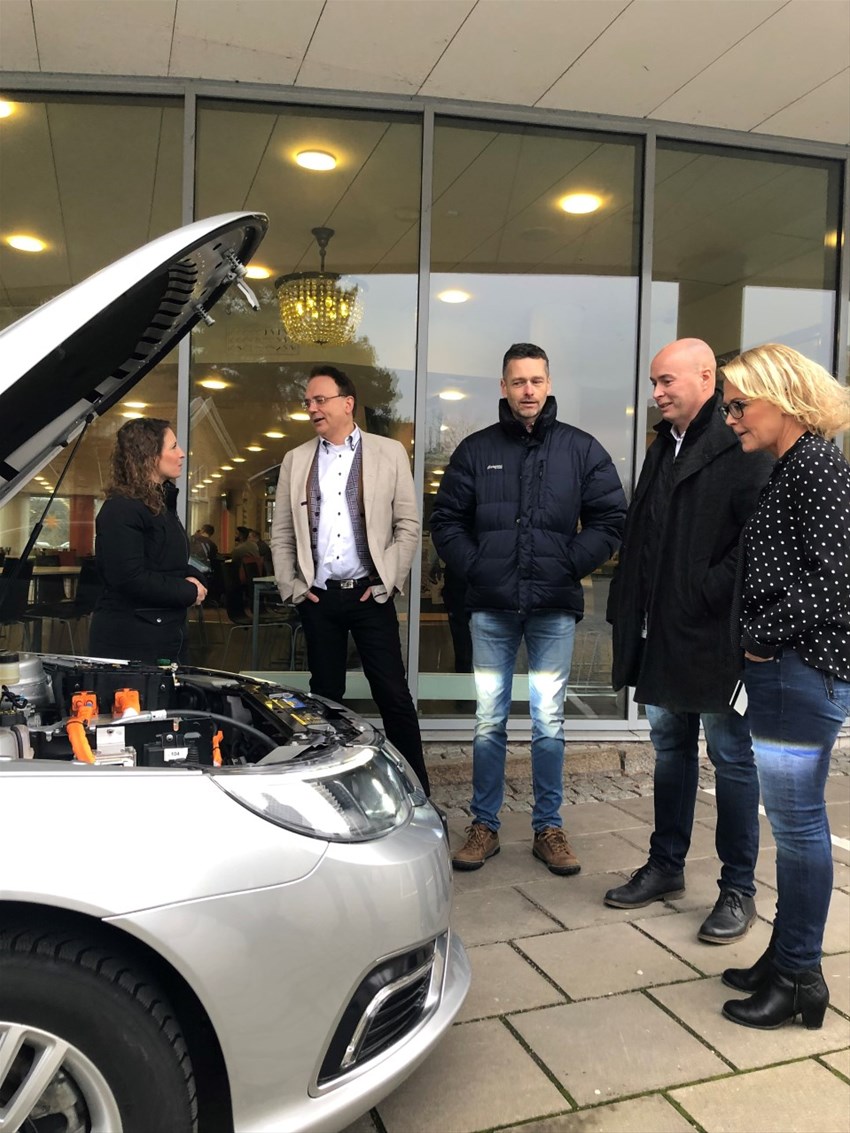Prepared to share a car with others?
27 Dec 2018
Electric car maker NEVS in Sweden wants to map people's transport behavior. Can the citizens in Trollhättan where NEVS is situated, think of sharing cars with others, if it´s done smoothly and the transportation costs are significant reduced? This is the question to be answered in a project, SESMA, which also includes Trollhättan City, University West and RISE.

Gathered around the car: Nadia Kabir (NEVS), Martin Hellström (University West), Driver (NEVS), Stefan Jansson (Eidar) and Ulrika Lundh Snis (University West).
Photo: Anna Hallberg, University West
NEVS would appear to be the only car manufacturer in the world to claim that the total number of cars has to be reduced. This attitude is also shared by Trollhättan City, which wants to be a sustainable town and live up to environmental goals, including reducing residents' car ownership and car traveling. Now, researchers at the University of West Sweden will combine these needs and look at the possibilities of expanding the use of cars that are part of a system that deals with the use of the cars.
NEVS will set up five electrical vehicles for the SESMA project. SESMA stands for Sharing Economy, Smart Mobility Acceptance.
At the moment, we hear a lot about smart cities and autonomous cars, but at the same time there is not much research made on how users can use these services. Until now, the focus has mainly been on the technical solutions.
"The technology exists, but we know very little about how people react on this or about people's attitudes towards self-driving cars and their relationship with car sharing services," says Lars-Olof Johansson, researcher in computer science with a focus on work-integrated learning and project leader at the University West.
To be easy with new mobility solutions
NEVS participates in the project to learn more about enabling sharing economics through new mobility services, where future transport is based on sharing vehicles. This should be as easy as if you own your own car - but the costs will be significantly lower.
"We at NEVS strive for a sustainable future and part of that is to reduce the number of cars. Since we know that most cars are parked 95% of the time, it should be possible to make people think new and dare to start sharing cars with others. We are not only focusing on the positive environmental impacts; the fact that you can halve your car costs is also a very important incentive, "says Nadia Kabir, project manager at NEVS
"We believe that such an arrangement would be appealing to many and are really looking forward to having this tested in practice," adds Nadia Kabir.
For NEVS, this is a first step towards developing future mobility solutions in collaboration with Trollhättan City and other actors.
In particular, Lars-Olof Johansson emphasizes a few things that are extra noteworthy and also been the origin of the project.
"One is that if we are to succeed in reducing car traffic, we need to start sharing services with each other - otherwise there won´t be fewer cars. The second is that the attempts made with self-driving cars have always been done in big cities. In size, there are many cities that are similar to Trollhättan in Sweden - but how it works in these is unknown.
Lars-Olof Johansson further explains that a crucial factor for Trollhättan City´s involvement in the project is the construction of a new neighborhood in Trollhättan and planning of parking spaces versus green areas.
Follow with families in everyday life
The main purpose of the project is to investigate and chart the existing mobility and transport habits of individuals, as well as their perceptions and experiences of shared self-driving transport with electric cars in practice. This will essentially be done by two major mappings. The first is a survey of residents' transport behavior in Trollhättan. It will be done with the help of families who will become study subjects that followed in their everyday lives. The second is about testing an attempted sharing of electric cars, also within families.
"We want to find out how we can build services around this with the families as co-producers of apps or anything else that could appear. We know that when users join and form services and digital applications, acceptance also increases, "says Lars-Olof Johansson.
The project itself will not include self-driving vehicles, but later on the results will be applied in the continued work of developing shared and autonomous vehicles.
SESMA will last throughout 2019 and 2020 and will be done in cooperation with NEVS, Trollhättans City and RISE. The project has just been granted more than SEK 3 million from
Drive Sweden * and has a total budget of almost SEK 7 million.
* Drive Sweden is a strategic innovation program initiated by government. The program is funded by the Swedish Energy Agency, Formas and VINNOVA.
Objectives with project SESMA
1. Create a business model for manufacturers of connective, autonomous, electric and shared vehicles. In this case, NEVS is the actor.
2. Create urban planning guidelines for transition to smart mobility in major cities: The actor is Trollhättan City.
3. Develop demonstrators of digital applications that support sharing economics and smart mobility in major cities. (Developed by all the actors of the project.)
For more information, please contact
• Nadia Kabir, Project Manager Mobility Solutions at NEVS, +46 739666369.'
• Lars-Olof Johansson, Project Manager, University of West Sweden, lars-olof.johansson@hv.se +46 70-683 33 38
• Ulrika Lundh Snis, Researcher in Informatics, University West, +46 7303862239
• Håkan Falck, Head of Growth and Development Office, Trollhättan City, +46 520497965
Text and photo: NEVS


